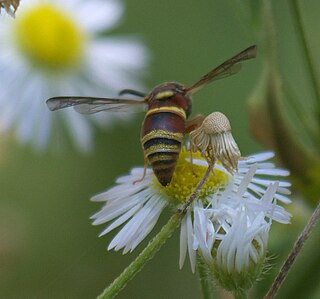
Corallus, the neotropical tree boas, are a genus of boas found in Central America, South America and the West Indies. Nine extant species are recognized as of 2017.

The whitemargin unicornfish, also known as the ringtailed unicornfish or short-horned unicorn-fish, is a tropical fish found throughout the Indo-Pacific. It can reach a length of 100 cm, making it one of the largest members of the family Acanthuridae.

Siphonops annulatus, the ringed caecilian, is a species of caecilian in the family Siphonopidae endemic to South America. It may have the broadest known distribution of any terrestrial caecilian species.

Siphonops is a genus of caecilians in the family Siphonopidae, found in South America. All species are known to occur within Brazil, however, only S. hardyi and S. leucoderus are endemic to it. The native ranges of the other two known species, S. annulatus and S. paulensis, extend outwards into the surrounding countries of Argentina, Bolivia, and Paraguay. S. annulatus's range extends even further, stretching into Colombia, Ecuador, French Guiana, Guyana, Peru, Suriname, and Venezuela, and giving it perhaps the most widespread distribution of any single caecilian species.

The clown killi or banded panchax, is a species of fish in the family Nothobranchiidae, an African rivuline, native to fresh water habitats in Guinea, Liberia and Sierra Leone in West Africa.

Corallus annulatus, known as the ringed tree boa, annulated tree boa, and northern annulated tree boa, is a boa species found in Central and South America. Three subspecies are currently recognized, including the nominate subspecies described here. Like all boas, it is a non-venomous constrictor.
Gyas annulatus is a species of harvestmen in the family Sclerosomatidae from the Alps.

Labidiaster annulatus, the Antarctic sun starfish or wolftrap starfish is a species of starfish in the family Heliasteridae. It is found in the cold waters around Antarctica and has a large number of slender, flexible rays.

Sphoeroides annulatus is a species in the family Tetraodontidae, or pufferfishes. It is found in the eastern Pacific Ocean from California, USA to Pisco, Peru and the Galápagos Islands.

Macrogomphus annulatus, commonly known as Keiser's forktail, is a species of dragonfly in the family Gomphidae. It is native to India and Sri Lanka. Two subspecies are recognized, which are geographically separated.

Tubulanus annulatus, commonly known as the football jersey worm, is a species of ribbon worm in the phylum Nemertea. It ranges across the northern Atlantic Ocean, the North Sea and the Mediterranean Sea, being present from the lower shore down to about 40 m (130 ft), on sand, gravel and other habitats.

Cyrtodactylus annulatus, also known as the annulated bow-fingered gecko or small bent-toed gecko, is a species of gecko endemic to the Philippines.

Euodynerus annulatus is a species of stinging wasp in the family Vespidae.

Lasiomerus annulatus is a species of damsel bug in the family Nabidae. It is found in North America.
Psilonyx is a genus of robber flies. There are about 14 described species in Psilonyx.

Pachynematus is a genus of common sawflies in the family Tenthredinidae. There are at least fifty described species in Pachynematus.
Pyrgocorypha is a genus of coneheads in the family Tettigoniidae. There are about 16 described species in Pyrgocorypha, found in the Americas, southern and eastern Asia.

Hylaeus annulatus, is a species of hymenopteran in the family Colletidae. It is found in North America and Europe.

Scaphiodontophis annulatus, commonly known as the Guatemala neckband snake, is a species of snake in the family Colubridae. The species is native to southern Mexico, Central America, and Colombia. There are four recognized subspecies.
















